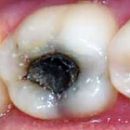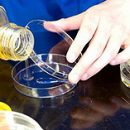Frequent pathology causing serious health problems - the formation of polyps in the nose. Why grow up what happens how do they show. What to do when they grew up how to treat.
Content
- The main provoking factors for the growth of polyps in the nose
- How the polyp is formed in the sinus nose
- Polyps in the nose: Symptoms and Stages of Education
- Nasal Polyps: Diagnostics
- Polyps in the nose: We choose treatment correctly
 The polyp is called the abnormal growth of the mucous membranes, forming a grow, towering over the mucous membrane of any organ. In the nose, the polyps are called nasal, their growth is most often accompanied by an allergic rhinitis. They have no nervous endings, they are not sensitive to touch and easily move, outwardly reminding grape bunch. More correctly this pathology is called «Polypose rhinosinusitis», and the polyp is considered as a benign tumor.
The polyp is called the abnormal growth of the mucous membranes, forming a grow, towering over the mucous membrane of any organ. In the nose, the polyps are called nasal, their growth is most often accompanied by an allergic rhinitis. They have no nervous endings, they are not sensitive to touch and easily move, outwardly reminding grape bunch. More correctly this pathology is called «Polypose rhinosinusitis», and the polyp is considered as a benign tumor.
The exact reason that causes the mucous cloth to perform metamorphoses, leading to the growth of nasal polyps, is not known.
The main provoking factors for the growth of polyps in the nose
Like any disease, polypose rhinosinusitis occurs due to a number of factors that provoke the growth of polyps in the nose:
- Infectious diseases of the upper respiratory tract, chronic character: rhinitis, sinusitis, front;
- chronic allergic ailments;
- fungal infections;
- fibergation;
- hereditary predisposition;
- Physiological or traumatic disruption of the structure of the nose (fracture and curvature of the nasal partition, narrow nasal moves);
- intolerance to salicylic acid.
How the polyp is formed in the sinus nose
 The mechanism of the formation of a polypa in the sinus of the nose is simple. The presence of a constant infection in the nose forms persistent inflammation. Mucous membrane that has protective functions tries to resist the infection. Initially, the body succeeds «Win» inflammation. If the long-awaited treatment does not come to the aid, the arsenal of protection of the mucous membrane is depleted. Then the body, trying to compensate the gap of the incapable mucous membrane, is in a hurry to grow a new strong mucous membrane. This leads to a polypoticonation of fabric.
The mechanism of the formation of a polypa in the sinus of the nose is simple. The presence of a constant infection in the nose forms persistent inflammation. Mucous membrane that has protective functions tries to resist the infection. Initially, the body succeeds «Win» inflammation. If the long-awaited treatment does not come to the aid, the arsenal of protection of the mucous membrane is depleted. Then the body, trying to compensate the gap of the incapable mucous membrane, is in a hurry to grow a new strong mucous membrane. This leads to a polypoticonation of fabric.
Distinguish the following types of polyps:
- formed in a gaimor sinus (found rarely, growing on one side, more often in children);
- The labyrinth generated in the lattice (grow on both sides, arise in adults).
The beginning of the polyp occurrence is difficult to diagnose due to the duration of its growth: from 2 to 4 years. Grown in the nose, polyps, starting their education in the sinuses, gradually descend into the nasal cavity, partially closing the passage for breathing. Such respiratory discomfort in the nose is manifested by various symptoms.
Polyps in the nose: Symptoms and Stages of Education
The disease takes three stages of development:
- I — Polypa closure only the top of the nasal partition;
- II — Closed already more than half of the space;
- III — Full overlap of space.
Symptoms of grew polyps Pretty explicit. Select the following:
- nasal congestion, which is not treated with local medication;
- arising progressive sinusitis, which leads to the absence of nasal breathing;
- frequent fatigue;
- gradual decline and loss of smell;
- Sometimes disorders of taste;
- separation from a nose of a purulent or mucous nature;
- frequent colds (due to the fact that there is no air circulation through the nose, the nasal moves are not cleared and not moistened, the beneficial environment is created for the growth of all sorts of bacteria);
- The appearance of the feeling that the foreign body is in the nose;
- headache;
- soreness in the area of the sinuses of the nose;
- Possible tonsillites, otitis, reduced hearing.
Nasal Polyps: Diagnostics
To diagnose nasal polyps, exist the following studies:
- visual, palpator inspection;
- Rososcopy;
- x-ray;
- Computer tomography nasal sinuses.
Polyps in the nose: We choose treatment correctly
Treatment of polyps formed in the nose can be both drug and surgical. To identify the growth of polyps at the initial stage is not possible, and patients appeal to the doctor, already having characteristic symptoms of the formed polyps. In such cases, medication therapy is not effective. Surgical treatment is applied.
The operational method offers:
- Removal using a loop (outdated and ineffective method allowing polyps to grow re-in a year).
- Removing polyps in the nose with a laser (painless, gentle method) has limitations:
- It is used in the occurrence of one polypa small size;
- Recurrent frequencies, since polypose fabric in sinuses can not be removed.
- Endoscopic method (allows you to estimate the situation using the monitor and completely remove polypose fabric, eliminating the patient from recurrence for many years).
With properly selected treatment after an endoscopic operation of removing polyps in the nose of their appearance can be avoided. Postoperative therapy is long and includes:
- local nasal mucosa care;
- Medication tools — intranasal hormonal sprays;
- No hyrochion.









